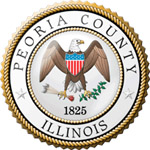 The results are in. I received the following press release from the county with supporting documentation. My comments follow:
The results are in. I received the following press release from the county with supporting documentation. My comments follow:
Description
On February 25, 2008, the County of Peoria conducted a phone survey of approximately 1000 registered voters living in Peoria County: 500 within the City of Peoria, 500 outside city limits. The survey’s intent is to gauge voter support of a tax increase to fund the $24 million requested of the County for the Museum Project.
Survey respondents were selected randomly from a pool of registered voters who voted three times since 2004, including voting in at least one local election. The survey was conducted both during the day and in the evening to poll a broader range of voters. Survey administrators called as many residents as necessary to garner results from approximately 500 households in both the city and in the county; 1009 total surveys were completed.
The survey is attached to this report.
Results
Survey results indicate 31% (30% in the day, 32% in the evening) of residents in the City of Peoria receiving the phone survey did participate in the survey. The survey administrator felt 30% participation is a good response. Compare this to only 17.5% of people in the County: 18% during the day, 17% in the evening. The survey administrator believes the lower percentage of response in the county indicates people in the county are either less aware of the museum or do not care as much about the museum as those living in the City.
Of the total respondents (City and County), 69.4% or 700 felt the museum is beneficial to the region. These respondents then proceeded to the second survey question: “which of three funding sources would you support to aid the Riverfront Museum?” Of the 700, 691 responded to this question. Their responses are as follows:
- Support property tax increase for Peoria County property owners: 4.6% [32]
- Support multi-county property tax increase for region: 21.1% [146]
- Support temporary sales tax increase of .025% in Peoria County: 31.8% [220]
- Undecided or does not support tax increase: 42.4% [293]
The survey administrator felt very positive that less than 50% of the respondents were either undecided or do not support a tax increase. In other words, more than 50% of the polled voters would support a tax increase to help fund the Museum Project.
Survey results are attached to this report.
My take: With all due respect, the survey administrator has made a terrible error. I encourage you to click on the Survey Results link above (last sentence of the press release) and look at the raw numbers; they’re easier to understand and compare than percentages.
I quote Peoria County Director of Strategic Communications Jenny Zinkel from a response she sent to my previous post on this survey: “We believe if a citizen does not feel the museum is beneficial, he or she would not support a tax increase to fund the museum.” So, a “no” response to question 1 means they do not support a tax. Thus, here are the results the way I figure them:
Those who do not support a tax: 602 respondents (309 who answered “no” to question 1, plus 293 who answered “yes” to question 1 and “undecided or no tax” on question 2).
Those who support a tax: 398 respondents (those who answered “yes” to question 1 and chose a tax option in question 2).
For those of you who like percentages, that’s 60.2% against a tax increase, and only 39.8% for a tax increase. I frankly don’t see how the survey administrator could have come to any other conclusion. If they don’t consider “no” votes on question 1 as “no” votes against a tax, then in my opinion, they’ve invalidated the survey because they’ve screened people who, by the County’s own admission, would have most likely voted against a tax increase in question 2.
Kudos to the County for releasing the raw survey data so that the survey administrator’s conclusion could be either verified or challenged. In this case, I think it has to be seriously challenged. It’s clear that there is less than 50% support for a tax increase.
UPDATE: I corrected my numbers from earlier. I failed to take out the 9 people who answered question one positively, but then declined to answer question 2 (presumably by hanging up).
UPDATE 2: Merle Widmer has more information on the continuing efforts of museum officials to force this project down our throats.

 The results are in. I received the following press release from the county with supporting documentation. My comments follow:
The results are in. I received the following press release from the county with supporting documentation. My comments follow: The City of Peoria will host a public open house at Columbia Middle School, 2612 North Bootz Avenue on Wednesday, March 5, 2008 from 7:00 p.m. to 9:00 p.m. The purpose of this open house is for the public to review the scope of a study and master plan to implement a streetscape improvement project for the Form District known as the Sheridan Triangle Business District, and to provide input to the public master plan process. The intent of the project is to revitalize the character of the streets in the study area to create urban, pedestrian-friendly streets through narrower travel lanes, wider sidewalks and a tree canopy, as well as other improvements to be determined through this public master plan process.
The City of Peoria will host a public open house at Columbia Middle School, 2612 North Bootz Avenue on Wednesday, March 5, 2008 from 7:00 p.m. to 9:00 p.m. The purpose of this open house is for the public to review the scope of a study and master plan to implement a streetscape improvement project for the Form District known as the Sheridan Triangle Business District, and to provide input to the public master plan process. The intent of the project is to revitalize the character of the streets in the study area to create urban, pedestrian-friendly streets through narrower travel lanes, wider sidewalks and a tree canopy, as well as other improvements to be determined through this public master plan process. I’ve received several reports from readers that the Peoria Riverfront Museum folks are conducting a poll:
I’ve received several reports from readers that the Peoria Riverfront Museum folks are conducting a poll: Another dissatisfied CityLink customer wrote a
Another dissatisfied CityLink customer wrote a